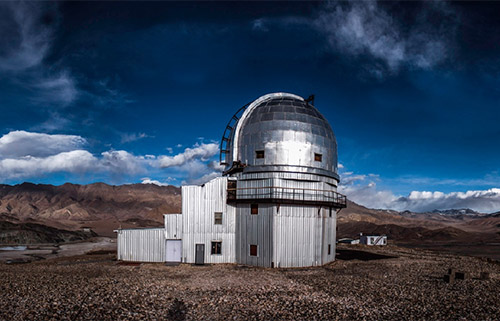The Biggest Optical Telescope In India Is Situated At The

The Biggest Optical Telescope in India is Situated at The Indian Astronomical Observatory
The biggest optical telescope in India is situated at the Indian Astronomical Observatory, Hanle, Ladakh. This telescope is known as the Himalayan Chandra Telescope (HCT), and it has a mirror diameter of 2.01 meters. The telescope is operated by the Indian Institute of Astrophysics and is one of the largest telescopes in Asia.
The HCT is located at a high altitude of 4,500 meters in the Himalayas, which provides an excellent observing environment with clear and stable skies. The telescope is designed to observe celestial objects at optical and infrared wavelengths and is equipped with advanced instruments such as the Himalaya Faint Object Spectrograph Camera (HFOSC) and the Near Infrared Camera and Fabry-Perot Spectrometer (NICS).
The HFOSC is a multi-mode instrument that is used for spectroscopy and imaging of celestial objects. It is designed to observe faint objects in the optical wavelength range and can detect objects with a brightness of up to 24th magnitude. The NICS is used for observing in the near-infrared wavelength range and is capable of detecting objects with a brightness of up to 20th magnitude.
The HCT has contributed significantly to astronomical research in India and has been used for various observations, including the study of active galactic nuclei, star formation regions, and the search for exoplanets. It has also been used for conducting educational programs and training students in astronomy and astrophysics.
Why We Need The Biggest Optical Telescope
The biggest optical telescopes like the Himalayan Chandra Telescope (HCT) in India are essential tools for astronomical research and exploration. Here are some reasons why we need the biggest optical telescope:
- To study distant celestial objects: Optical telescopes can capture the light emitted by celestial objects such as stars, galaxies, and quasars. The bigger the telescope’s mirror diameter, the more light it can capture, enabling astronomers to observe and study fainter and more distant objects in the universe.
- To explore the mysteries of the universe: The study of the universe is an ongoing endeavor, and optical telescopes have been instrumental in exploring and discovering new phenomena. For example, using the HCT, astronomers have studied the formation of stars and galaxies, the evolution of black holes, and the search for exoplanets.
- To understand the fundamental laws of physics: Astronomers use optical telescopes to observe and study celestial objects and their behavior. These observations can help us understand the fundamental laws of physics that govern the universe, such as gravity, electromagnetism, and the nature of matter and energy.
- To inspire future generations: Optical telescopes, especially the biggest ones, can inspire future generations to pursue careers in science and engineering. They provide an opportunity to learn about the universe and the scientific method, fostering curiosity and innovation.

What Are the Limitations of The Biggest Optical Telescope
While the Himalayan Chandra Telescope (HCT) in India is one of the largest optical telescopes in Asia, it still has certain limitations. Here are some of them:
- Atmospheric conditions: The atmosphere can have a significant impact on the quality of observations made by the telescope. Factors such as turbulence, humidity, and air pollution can affect the clarity and resolution of images obtained by the telescope.
- Limited field of view: The HCT has a relatively narrow field of view, meaning it can only observe a small portion of the sky at a time. This limitation makes it difficult to conduct wide-area surveys and observe fast-moving objects.
- Observing time: Due to the high altitude and remote location of the HCT, observing time can be limited. Harsh weather conditions, extreme temperatures, and other logistical challenges can also affect the amount of time astronomers can spend observing with the telescope.
- Maintenance and upgrades: Maintaining and upgrading a large telescope like the HCT can be costly and time-consuming. Keeping the telescope in good working condition and ensuring that its instruments remain up-to-date requires ongoing investment and resources.
Where You Buy The Biggest Optical Telescope in India
The Himalayan Chandra Telescope (HCT) is not available for purchase by individuals or organizations. The HCT is a professional-grade astronomical instrument that is owned and operated by the Indian Institute of Astrophysics (IIAP) for scientific research and education purposes.
However, if you are interested in purchasing a telescope for personal use, there are many options available in the Indian market. You can visit a local astronomy store or check online retailers such as SSEA India, Amazon India, or SSEA Telescopes to browse through a wide range of telescopes and accessories.
When choosing a telescope, consider factors such as the type of observation you want to do, the size and portability of the telescope, the quality of optics and mount, and your budget. It is also recommended that you do some research on the different types of telescopes and their specifications to make an informed purchase decision.
It is important to note that observing the night sky with a telescope requires proper training and safety measures to prevent damage to your eyes and equipment. Therefore, it is recommended that you seek guidance from an experienced astronomer or a local astronomy club before making a purchase and using the telescope.
- Enhanced Visibility and Reach:
Local SEO is the compass that guides local customers to your doorstep. By optimizing your online presence for local searches, you increase the likelihood of appearing in local search engine results pages (SERPs). This heightened visibility ensures that your business is readily discoverable by individuals in your geographical vicinity.
- Mobile Dominance:
With the ubiquitous use of smartphones, local searches have become a daily ritual. People are constantly seeking local services, products, and information on the go. Local SEO ensures that your business not only appears in local search results but also adapts seamlessly to the mobile user experience, a critical factor in the digital age.
- Trust and Credibility:
Local SEO fosters trust and credibility among your target audience. When your business consistently appears in local searches, it establishes a sense of reliability. An optimized Google My Business (GMB) profile with accurate information and positive reviews contributes significantly to building trust with potential customers.
- Competitive Edge:
In a competitive marketplace, local SEO provides the edge your business needs to stand out. When consumers search for products or services in your area, a well-optimized local SEO strategy can elevate your business above competitors, making you the preferred choice based on visibility, relevance, and online reputation.
- Community Connection:
Local SEO is not just about algorithms; it’s about community connection. By tailoring your digital strategy to your local audience, you demonstrate a genuine commitment to the community. Engaging in local events, leveraging community-focused keywords, and showcasing your involvement through online channels strengthen your ties with the people you serve.
- Cost-Effective Marketing:
Traditional advertising can be costly, and the return on investment isn’t always guaranteed. Local SEO, on the other hand, is a cost-effective marketing strategy with tangible results. It targets individuals actively searching for your products or services, making each click more likely to convert into a customer.
- Adaptability to Evolving Consumer Behavior:
As consumer behavior evolves, so must your marketing strategy. Local SEO is adaptable to changes in search algorithms, user preferences, and technological advancements. By staying ahead of the curve, your business remains relevant and continues to meet the evolving needs of your local audience.






